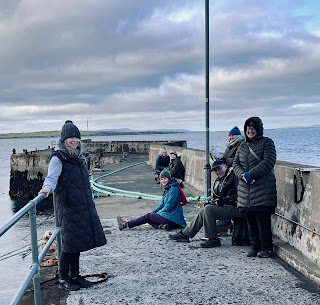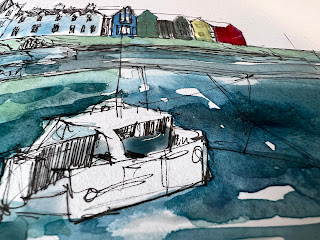I took a small group of artists out for a sketchbook class one Sunday and we settled at John O’Groats harbour. Thankfully it was unseasonably warm which made the whole experience very pleasant for outdoor drawing in March (from this photo you will see we dressed for the expected temperature but we were able to sit comfortably for 2 hours) This is the north of Scotland after all, who doesn’t come dressed with woolly hats and fingerless gloves at this time of year!
A collaboration between John O’groats Mill Trust and Lyth Art Centre funded the project. The aim, to offer an architectural tour around the newly refurbished mill and surrounding area.
The project was slightly behind schedule and therefore still technically a building site so we opted to not walk over to the mill as we’d have had to view it behind a tall fence at the path. It didn’t spoil our day though as we enjoyed tackling the colourful buildings of John O’groats with boats in the foreground. The island views, distant, still intact crofts on Stroma plus the lighthouse on the horizon and the changing lighting, which all offered a great variety for our short class.
This is what the class created in 2 hours.
My aim was to demonstrate and encourage the practice of speed sketching and there are many reasons for this including:-
- Creating quick thumbnail compositions that you can quickly disregard until you find the right one for you.
- Getting familiar with all the details in your view before you settle down to create a more substantial picture. You can also make the decision early on as to whether you think you’ll enjoy drawing what you’re seeing.
- Learning the skill of drawing faster makes for a more interesting, lively picture and your personality will show through
- And lastly, if you learn to draw faster, and have more pictures to experiment on with new mediums and techniques, you then won’t feel so precious and nervous about making a mistake or ruining it. Something exciting might come from your experimentation.
Here (below) is a page from that day, not my first sketch, that one was my regular ‘blind’ drawings or ‘no look’ drawings which I seemed to have binned (I encourage this, helps get the nervous energy to dissipate).
My second sketch ended up as a demonstration for all the other materials I suggested the students use during the class. It’s not correct in terms of proportion nor composition by any means but I enjoy looking back on it and zone in on aspects of what I’d like to try again. The fact that the end of the boat is missing illustrates the need to jot out composition first otherwise you run out of page which I did so here!
Once home I then decided to sit and tackle the peculiar vanishing point of the building, which didn’t sit right as the foreground slopes the other way, and probably the reason why most people opted to draw the boats and seascapes!
From a photo I took, I started by using my ruler to draw faint guidelines, both for the perspective on the hotel but also the actual lines of the harbour wall I would need to draw. (This often catches me out)
Holding the ruler up to the photo to decide whether the lines slope down, up or are horizontal (this line being the ‘eyeline’)
Once I’d pencilled in roughly all aspects of the view I wanted to draw, I then drew over the pencil with 0.03mm waterproof pen then rubbed out the pencil lines.
I then coloured in the painting with watercolour out of tubes, you get a higher concentration of pigment this way. (Travel cases are excellent for quick, outside
colouring-in)
This close up shows you a thick droplet of watercolour I’ve left on the boat which I waited and left to dry so I’d get a coloured edge. This is an effect I like, not necessarily the correct way, but I tend to rebel against ‘rules’ to make something different.
A tip which works for painting the odd fine dark lines, is that I use a sharp point to scribe a line in, this works well for telegraph wires, and then I wash over with watercolour, the line holds the paint. Just be careful not to cut too deeply!
I added pastel crayon over the dark water to create ripples on the surface. I’m a great fan of adding other mediums in to my pictures.
After my first attempt at this view, I’d say there are elements of it that I enjoy, but as a whole, I am likely to develop it further.
UV In my next blog, I’ll show you how I take aspects of this view and develop it in an abstract way.
[Ps I’d like to thank 8 doors distillery who provided us with fantastic coffee and cake afterwards, and Lyth who arranged the whole thing.]









Comments